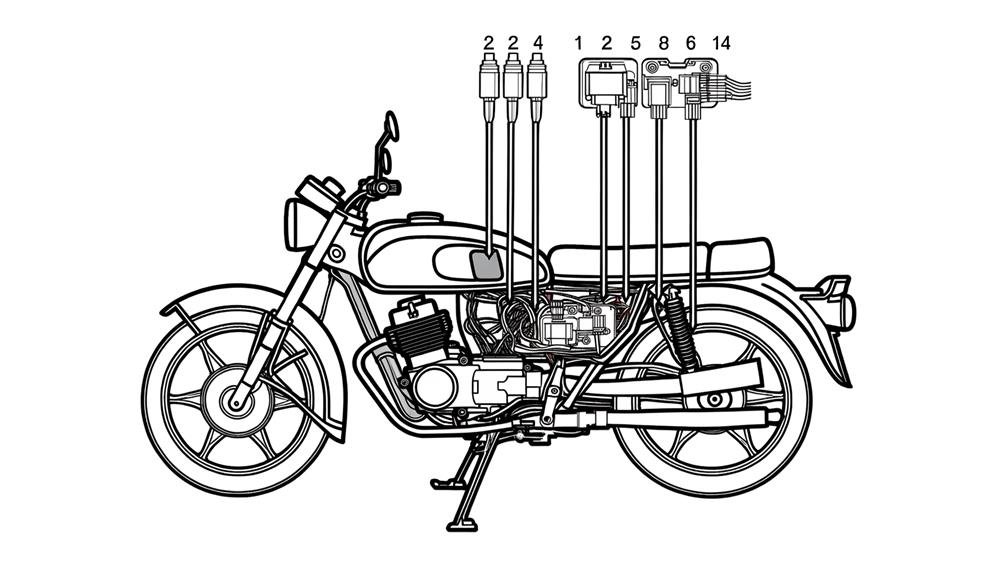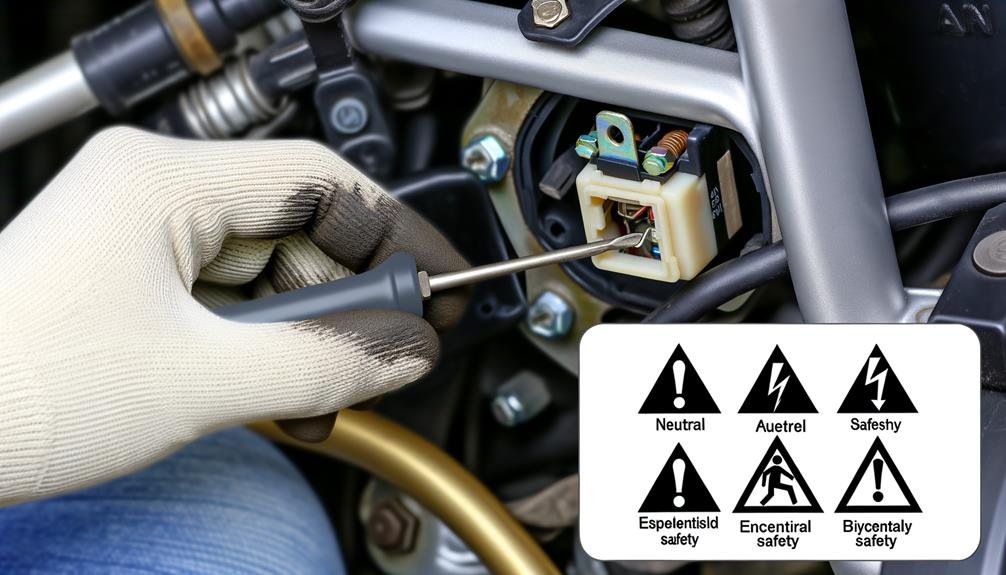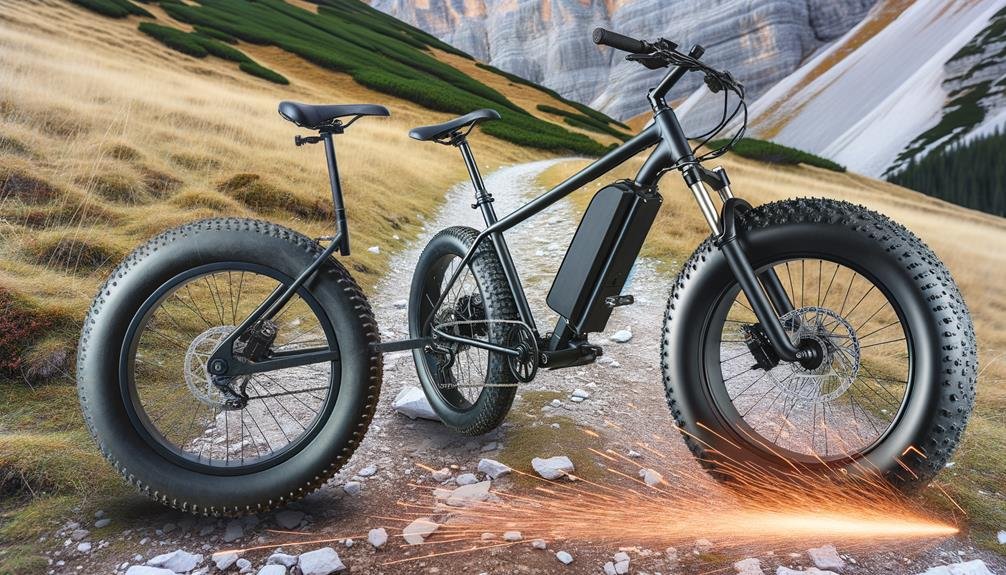Charles Miller is a veteran bike enthusiast with over 12 years of experience dealing with bikes as a mechanic. Despite immense love and expertise for...
Imagine you're out on a weekend ride, soaking in the scenic beauty, when suddenly your motorcycle refuses to start due to a malfunctioning neutral safety switch. We've all been there, haven't we?
A faulty neutral safety switch can be a real dampener, putting our biking plans on hold. But what if there was a way to bypass the switch and get back on the road? In this discussion, we'll explore how to safely and effectively bypass the neutral safety switch on a motorcycle.
But remember, while it's a handy skill, it's also a controversial one – bypassing safety features is always risky business. So, why should one even consider learning this? Ah, that's the intriguing part. Let's find out together.
Key Takeaways
- The neutral safety switch is a crucial component that prevents the engine from starting unless the transmission is in neutral or the clutch is engaged.
- Bypassing the neutral safety switch should only be done by experienced riders and with caution.
- Disconnecting the battery before attempting a bypass is essential to minimize risk.
- Bypassing the switch increases the risk of accidents and may void the motorcycle's warranty.
Understanding the Neutral Switch
To fully grasp the concept of the neutral safety switch, it's essential to note that this crucial motorcycle component prevents the engine from starting unless the transmission is in neutral or the clutch is engaged. This is the basis for understanding the neutral switch on a motorcycle. In essence, the neutral switch is the safety gatekeeper of your motorcycle's engine.
Now, if you're dealing with a faulty neutral switch, you might be considering a bypass. Knowing how to bypass the neutral safety switch can be handy for troubleshooting, but we can't stress enough that it's a task for experienced riders. It's crucial to disconnect the battery before attempting to bypass the switch, to minimize risk.
By locating the neutral safety switch and creating a bridge circuit, you can bypass the neutral safety system. However, bypassing this safety feature increases the risk of accidents and might void your motorcycle's warranty. Therefore, as a responsible rider, you must weigh the need for a bypass against possible legal implications and safety hazards.
In our community of riders, we value safety above all. Understanding the neutral switch and its bypass should be approached with caution and respect for the machine.
Required Tools for Bypassing
Before moving forward with a bypass, it's critical that we've the right tools on hand to ensure a smooth and safe process. The neutral safety switch bypass necessitates precision and care, requiring specific tools to handle the wires and electrical connections involved.
To perform the switch bypass effectively, we'll need:
- Wire cutters and strippers: These tools will allow us to cut and strip the wires connected to the neutral safety switch.
- Soldering iron and solder: We'll use these to join the wires after cutting, ensuring a secure connection.
- Heat shrink tubing and a heat gun: Once we've soldered the wires together, we'll cover them with heat shrink tubing and apply heat to seal the connection. This will protect the connection from damage and exposure.
Additionally, we may need insulation tape or electrical tape for added protection, and a multimeter for testing and verification. Ensuring the neutral light behaves as expected after the safety switch bypass is crucial.
Step-by-step Bypassing Process

Let's dive right into the step-by-step process of bypassing the neutral safety switch on a motorcycle, first by carefully removing the battery cables or wires.
Step 1: Remove the battery cables with utmost caution. Remember, safety always comes first.
Next, locate the neutral safety switch on your motorcycle. Once identified, proceed to take off the protective cover. This is a delicate process, so proceed with care to bypass a neutral safety switch without causing any damage.
Moving on, you'll need to disconnect the cables linked to the neutral switch.
Step 5: Disconnect these wires carefully, and then remove the switch from the motorcycle. Bypassing the neutral safety switch requires patience and precision, so don't rush.
Step 6: Reattach wires, ensuring they're connected properly. Then, reconnect the battery cables.
Step 8: Secure all cables, using insulation to prevent any potential electrical issues.
Step 9: Cover all exposed wires and loose ends for safety and aesthetics.
Last but not least, Test Your Work. Start your motorcycle and check if everything is running smoothly. If successful, you've successfully bypassed the neutral safety switch on your motorcycle. Congratulations! You're part of the DIY motorcycle maintenance community.
Avoidable Bypassing Mistakes
Diving headlong into bypassing the neutral safety switch on your motorcycle, it's crucial to understand potential pitfalls and avoid common mistakes. If not done correctly, bypassing the switch can lead to serious safety hazards, such as the bike being in gear unknowingly.
Here are three common mistakes to avoid:
- Improper Wiring: During the process, you need to Disconnect The Neutral Safety and Reconnect the Battery. Make sure all connections are secure. Exposed wires or incorrect wiring can lead to short circuits or electrical fires. Damaged wires should be a red flag, you should repair or replace them immediately.
- Ignoring the Safety Hazard: Bypassing the switch should never compromise safety. The neutral safety switch is there for a reason – it prevents the motorcycle from starting when the bike is in gear, preventing accidental movement. Ignoring this is a significant safety hazard.
- Skipping Steps: We can't stress enough how important it's to follow all the steps in order. The first step is often the most important one. Skipping it could lead to an unsuccessful bypass or even damage to your motorcycle.
Stay safe and remember, bypassing any safety feature should always be a last resort.
Post-Bypass Safety Tips

After successfully bypassing the neutral safety switch, it's crucial we conduct regular inspections of the modified setup to ensure all connections remain secure and undamaged. This is to prevent potential damage and ensure safety. We need to use electrical tape and shrink tubing to insulate any exposed connections.
Here are some critical points to remember:
| Task | How-To | Importance |
|---|---|---|
| Check Neutral | Always verify the bike is in Neutral before starting | Prevents accidental gear engagement |
| Battery Maintenance | Remove The Battery, reconnect the battery cables properly | Ensures smooth starting and operation |
| Ensure Connection Security | Regularly inspect all connections | Prevents loose or damaged connections |
| Model-Specific Instructions | Follow guidelines specific to your make and model | Ensures proper bypass procedure |
Frequently Asked Questions
Can a Neutral Safety Switch Be Bypassed?
Yes, we can bypass a neutral safety switch. However, it's worth considering the potential damage, safety implications, warranty risks, and legality before proceeding. We'd advise consulting a mechanic before making such modifications.
How Does a Motorcycle Neutral Safety Switch Work?
We're discussing the switch's functionality. It completes a circuit when in neutral, allowing the engine to start. This mechanical understanding is crucial for safe riding and maintenance. It's a key part of motorcycle mechanisms.
Can a Neutral Safety Switch Cause Crank No Start?
We've all faced starting issues, haven't we? A faulty neutral safety switch can indeed cause crank no start situations. This stems from ignition problems, starter relay issues, or even ignition circuit faults.
What Happens When a Neutral Safety Switch Goes Out?
When a neutral safety switch malfunctions, it impacts motorcycle performance and creates safety concerns. Identifying symptoms, understanding electrical complications, and estimating replacement costs require professional help. Maintenance tips can mitigate potential dangers.
Conclusion
We've walked you through the steps to bypass a neutral safety switch on a motorcycle. You might think this sounds risky, but with the right tools and a bit of knowledge, it's entirely doable.
Remember, safety is paramount – always double-check your work and ensure all connections are secure and insulated. If you're not confident, don't hesitate to seek professional help.
By being cautious and informed, you can successfully perform this technical task.

Charles Miller is a veteran bike enthusiast with over 12 years of experience dealing with bikes as a mechanic. Despite immense love and expertise for his Tacoma, he rides his Trek Ebike more. Anytime you meet him, you’ll either hear him talking about Bikes, or writing about all things bikes and cars on this blog.
More Posts


